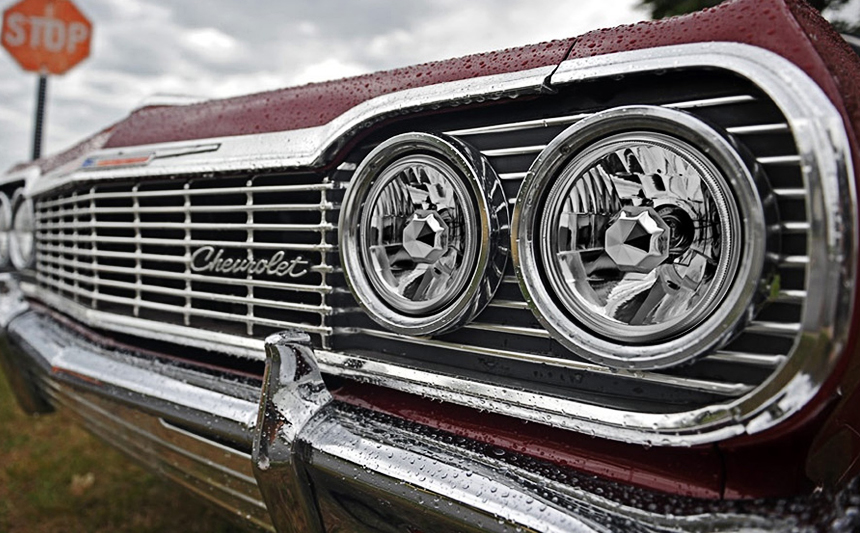Sealed Beam Headlights

BRIEF HISTORY OF SEALED BEAM HEADLIGHTS
Before 1939, most cars used circular stand-alone lamps that were not standardized in design. To solve supply problems, the U.S. government passed a law in 1940 that required all cars to use two 7” round sealed beam headlamps. Each produced both a high and low beam.
The law was changed in 1957 to include the use of four sealed beam headlamps - each measuring 53/4”. Car manufactures fitted two to produce a low beam and the other two to produce the high beam. The lights could be fitted diagonally, vertically, or horizontally.
The law changed again in 1975 to allow car manufactures to fit rectangular headlamps. Most cars switched in the late 1970s. The U.S. government then amended the law again in 1984 to allow the use of composite headlamp assemblies. For the first time, vehicles could have replaceable bulbs.
Most carmakers changed to composite headlights in the early 1990s. Some retained the less-expensive sealed beam headlights and even offered them in models produced as late as 2017. Today, all new cars feature composite headlights.
BENEFITS OF SEALED BEAM HEADLIGHTS
- Affordable
- Prevent moisture and debris from penetrating
- Easier to maintain thanks to the sealed unit
- Produce bright light due to brighter reflector material
- Offer farther and clearer visibility
- Consist of glass which does not dull when exposed to the elements
- Types of sealed beam headlights
Sealed beam headlights use parabolic aluminized reflectors (PAR). They are also referred to as PAR lamps and are available in either rectangular or round varieties. Round sealed beam headlights are expressed in eighths of an inch. The most popular sizes include:
- PAR30
- PAR36
- PAR38
- PAR46
- PAR56
- PAR64
For example, a PAR64 sealed beam headlight has a diameter of 64/8”. That is 8 inches. In the mid-1970s, most vehicles in the USA came with four 53/4” lamps or two 7” lamps. The former is a single beam headlight that runs only a low or high beam while the latter is a dual beam that operates both as a low and high beam.
Rectangular sealed beam headlights are expressed by their length and width. For example, 4”x6” or 7”x6”. When buying sealed beam headlights, buyers get to choose a chrome or black housing to help liven them up. No matter the type of housing, the headlights are available in the same size.
BULBS USED IN SEALED BEAM HEADLIGHTS
Many sealed beam headlights consist of a halogen bulb or an LED strip. They provide a unique styling statement, even though luminosity of most bulbs may not be the best. The most common bulb sizes you’re likely to find in a sealed beam headlight include:
- H4666
- H6024
- H4651
- H4656
- H6054
REPLACING A SEALED BEAM HEADLIGHT
The first step when replacing a bulb in a sealed beam headlight is to figure out what type of headlight you have. If the bulb reflector and lens are completely sealed with no way to access them, the entire assembly has to be replaced.
However, in case the headlight consists of separate parts that can be easily removed, then you have a composite headlight. This sometimes takes the form of a lamp that cannot be taken out of the car, but has a collar on the backside where the wires attach.
Simply remove the bulb from the backside and replace it. Pay attention to your vehicle’s lighting setup. A 2-light system includes both low and high beams while a 4-light system comes with separate bulbs for low and high beams. Sealed beam headlights with a 4-light system tend to be smaller in size.
CONCLUSION
Today, many people are choosing to convert their sealed beam headlights using HID and LED kits. This helps to provide a much better light output. It also prevents the need to replace the entire headlight when the bulb goes bad. You get a modern fit and better visibility on the road.
Recent Blog Posts
November 29, 2022

One of the best solutions for fixing hazy headlights is to wet sand them. While there are other ways you can clear up your oxidized headlights, few methods work as great as wet sanding. It not only cleans the plastic lens completely but also achieves permanent results.
November 29, 2022

Headlights that have turned yellow can make a car look really old. The foggy coating that covers the headlight tends to reduce the amount of light emitted on the road. This can affect the driver’s visibility and make it hard to maneuver dark roads.
November 29, 2022

There are plenty of solutions out there when it comes to cleaning the outside of your headlights. You can easily remove the yellow coating that forms on the plastic lens using a few household products.